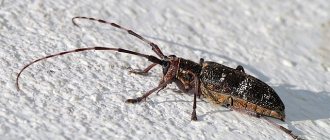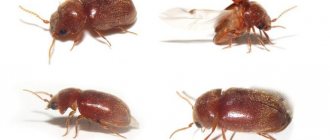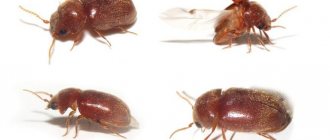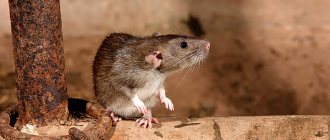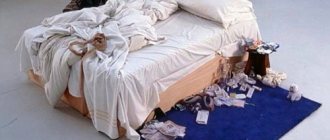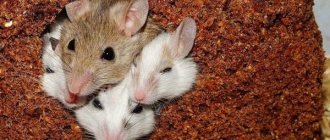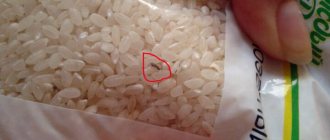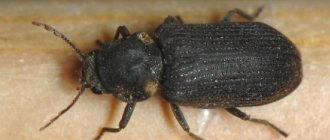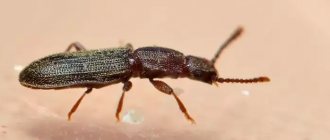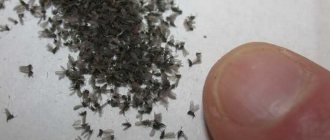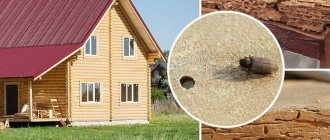Grinder beetles are insects from the order Coleoptera. The group is polymorphic, so it is difficult to find characteristics for all members of the family, but the general description is still the same for all.
The beetles are small in size, ranging from 1 to 10 millimeters; the most common are individuals 5 mm long. Their antennae are comb-shaped, consisting of several segments. The legs of the larvae are very developed, having claws with two scutes.
Beetles are found everywhere, the most common being the furniture borer, house borer and bread borer. Popularly, these insects are called woodborers, woodborers and woodborers, and the last of the woodborers is safe, but significantly harms supplies of other materials and food.
All beetles develop according to the same pattern and go through four stages. Females lay eggs in holes and crevices of dead wood. Then the larvae appear, they bite into the wood, eating out long, winding passages in it. Before the larvae transform into pupae, they move closer to the surface, the insect flies out and it is not the borer beetle that causes harm, but its larvae themselves. The larvae look like small worms, the body is white, and the head is dark brown.
The period of maturation of larvae from eggs is one to two weeks. They have very hard jaws; the larvae literally burrow into the wood. That part of the wood that has not had time to digest is thrown out; it represents drill flour, which clogs the passages. Larvae develop over a long period of time - from 12 months to several years. In some cases, this may be due to the rather late detection of this pest in a wooden house. Three weeks pass after pupation, and the cycle ends with the appearance of the beetle. This usually happens in early summer.
Grinders are ubiquitous. They destroy almost all deciduous and coniferous wood. Some of them make a sound similar to the ticking of a clock; this occurs during the mating period, when they hit their heads against the walls of the passage.
Beetles in the house - common types of borers
Let's take a closer look at some types of beetles that are quite common.
- Furniture grinder 2.5 - 5 mm long, dark brown, with stripes of dots on the elytra. The larvae are white and up to six millimeters long. The female lays eggs in darkened parts of furniture and wooden structures. Flight holes are oval, 1-2 mm in diameter. If conditions are favorable for the beetle, it can produce a couple of generations of offspring per year.
- The house grinder is black-brown in color, with golden spots on the back. Its length is 2.5 - 3 mm. The larvae are white, 7 mm long. The female lays eggs in flight holes and crevices. Coniferous wood located in places that are periodically moistened suffers from the effects of the larvae.
- The comb borer is 3-5 mm long and mainly affects deciduous wood. This species develops inside the tree for several generations, and after destruction, the beetles fly out en masse.
- The bread borer is a dangerous pest whose larvae eat mainly dry food and supplies of animal and plant origin.
Among the wood pests there are beetles of other families - bark beetles, longhorned beetles. For example, longhorned beetles and their larvae have an impressive size - up to 35 mm. Their larvae also gnaw holes in wood close to the surface.
Biological features of bark beetles
There are quite a few species of beetles that choose wood as a habitat; the general name of these pests is Scolytidae. A small bug, up to 1 cm in size, is prolific and active from early spring until the onset of frost. It is at this time that you need to worry about how to deal with bark beetles in a wooden house. Beetles feed on tree sap, leaving behind processed and undigested sawdust or dust.
The structure of the insect's body is adapted to penetrate the smallest cracks and push waste products out. The female insect looks for a suitable tree with the ability to easily penetrate under the bark, and, releasing pheromones, lures the male. The bark beetle's sense of smell is very sensitive, and it can determine the necessary habitat or the call of a female at a distance of up to 7 km.
After fertilization, the female prepares birth chambers in the tree trunk for laying eggs. The emerging larvae are the most dangerous pests for trees. The volume of nutrients required for the formation and growth of a larva is much greater than for an adult. The process of formation of a larva into a sexually mature individual takes 45-50 days. Adults can emerge twice during the warm season of the year. And it’s better to find out in advance how to get rid of the bark beetle in a wooden house than to wait for its population to increase.
Beetle grinder in the house - why it is dangerous
Carpenter beetles not only live in wooden structures, but also eat them. The ideal home for insects is wooden log houses. Lumber stored in stacks, especially logs and beams, are also attractive to them. Furniture can be eaten away by larvae to such an extent that at the slightest contact it crumbles into dust, the same applies to beams and ceilings.
The beetles are shy and are active mainly at night. It is not easy to see them, let alone catch them; when danger arises, the grinder pretends to be dead, so it is easy to mistake it for ordinary rubbish, and not at all for a living creature.
How to determine that a pest has appeared
The presence of pests in a tree can be easily determined by the presence of thin holes, about 2 mm. As a rule, wood flour is already pouring out of such holes. Based on these signs, one can judge that a woodworm larva (maybe more than one) lives in the tree. If you take a sharp tool and try to pierce the tree, you can determine the extent of damage to the wood. If the tool fits easily into the wood, then this design can be discarded and replaced with a new one. The best option is to burn the contaminated wood.
What means to fight the grinder in the house
As mentioned earlier, it is not the beetles themselves that cause damage to wood, but their larvae. Therefore, if there is a beetle grinder, the fight should be aimed primarily at destroying the larvae.
Folk remedies in the fight against the grinder:
- The simplest remedy is Vaseline oil. You need to take it into a pipette or syringe and insert it into the holes, then fill them with wax, paraffin or cover them with window putty. The oil is odorless, non-flammable, and does not contain substances that threaten human health. This treatment is especially suitable for bedside tables and cabinets where food is stored. The procedure should be repeated after two weeks. If no new holes appear within a month, then the grinder beetle is defeated.
- A good way to fill the holes with a mixture of three parts turpentine and one part kerosene is to use naphthalene dissolved in gasoline (8g naphthalene, 90g gasoline). Apply the mixture with a brush.
- The fight against the borer is highly effective if you use hot air heating, the temperature should be high up to +60° C. Or, conversely, to destroy the larvae you will need to freeze the temperature below - 2° C, for two days or more.
- Equal parts black carbolic acid, tar and naphthalene. The resulting mixture is used to fill the holes and passages.
How to get rid of grinders in your home forever
How to remove woodworm beetles using special preparations? Chemicals and insecticides are recommended for severe damage to furniture and wooden elements by the grinder.
A good remedy for woodworms is copper sulfate. It is diluted and douched, using a syringe, injected into each hole, after cleaning the passages from shavings.
When working with any insecticide, you should follow safety precautions - rubber gloves, respirator, goggles. After carrying out work, you must thoroughly wash your entire body. You can fight the borer using insecticides that contain cypermethrin, lambda-cyhalothrin (Paragraph product), or organophosphorus compounds. With the latter option, the most effective are products containing malathion - Medilis-Malathion, Karbofos, Fufanon-Super, fenthion - Medilis-Super, Dobrokhim FOS, and, of course, chlorpyrifos - Averfos, Chlorpirimark, Sichlor and others. Fufanon will be very effective, since when applied to wood, according to the instructions, it is more convenient to apply it with a brush. Repeated treatment is carried out after two weeks, and it is advisable to carry it out even though the beetles will disappear the first time.
Extermination measures are effective from the beginning of May until about mid-June. Just at this time, bugs emerge from the pupae; after they have tasted the poisoned wood, their ability to reproduce is lost.
In July, until the newly hatched larvae have climbed too deep, you can use Prima-71 aerosol, chlorophos, dichlorvos, potassium dichromate. Before you begin processing, you need to clean the holes, as they are clogged with drill flour; this can be done with a thin wire. When the holes are filled with the preparation, they need to be covered (even with bread crumb) so that the liquid does not evaporate.
Beetles in small furniture or wooden objects are removed by fumigation. You need to find a suitable plastic bag, place the item there and treat it with dichlorvos.
To protect finished buildings, bathhouses and habitable houses, fumigation using phosphine is used. The method is good if there is significant damage to the wood and there is no access to individual elements. Fumigation outdoors will not have an effect, since the method involves processing indoors. An important feature of the method is the penetration of gas into all cracks, cavities and nooks, due to the highest penetrating ability. This will get rid of the grinder, no matter what stage it is in. Phosphine is a harmful substance, therefore, after processing and exposure, degassing, that is, ventilation, should be carried out.
Fumigation with insecticides using aerosol fog generators will not give a positive result; during fogation (fumigation), the drugs do not penetrate deep into the wood.
The latest achievement in the field of killing the wood beetle is microwave radiation. This method underlies the creation of a device that kills all living things in wooden structures. The radiation heats the wood and all the inhabitants inside to a destructive temperature. The procedure is simple. An installation that looks like a tin box is moved along the wall. You need to go around all surfaces, periodically turning on the device. At this time, the bugs and larvae are simply fried inside the structures.
Fumigation and microwaves
Fumigation or fumigation is used when treating a room from the inside, since the gas on the street quickly dissipates and will not give a positive effect. Hydrogen phosphide is used for fumigation.
Microwave waves help to heat the wood, causing the pests to die. Microwave radiation is safe for the structure of the wood itself. The disadvantage of this method is that it is labor intensive and expensive. But for Clean-Profi professionals this amount of work will not be difficult; we will complete the processing in the shortest possible time.
Preventive agents against wood-boring beetles
Bugs in the house are uninvited guests and their appearance is easier to prevent. Grinder larvae can be found in ornamental wood, door and window frames, furniture, floors, and other building elements.
- Wooden varnished and unpainted surfaces should be wiped with a mixture consisting of ten parts of turpentine, five parts of paraffin and wax, and three parts of creolin. Wax and paraffin are pre-melted.
- To prevent the appearance of woodworm, you need to maintain order in the house, take care of the furniture, and monitor temperature and humidity indicators. If low-value furniture is already infested with pests, it is better to burn it.
- Before building a house and buildings, it is necessary to check whether the lumber is infested with beetles; the boards should not have bark (pests live there). Infested wood can be safely used as firewood.
- In a private house, you should regularly inspect the rafters, walls, floors and ceilings, and at the slightest suspicion, take active action.
- Grinder beetles love high humidity, so it is better to dry the bathhouse using ventilation.
- The most common method to protect wood is to treat it with antiseptics (biocide composition Zhuk, Belinka, Antishashelin, Lignofix, Antizhuk, Wood Healer). The method is universal, as it allows you to prevent the appearance of bugs and fungus in one treatment. Complex treatment is recommended, three times with breaks of three days. When wetted, the antiseptic does not penetrate deep into the wood; the method is only good as preliminary protection of entire structures and lumber. When choosing an antiseptic, you should pay attention to its composition. It should include chlorophos, sodium fluoride, potassium dichromate, ammonium silicofluoride, dichlorvos.
If you find a borer beetle in your home, do not panic. If they have just appeared, there will be enough time to draw up an action plan and begin to follow it. The larva destroys wood for several years, and the means to combat wood-boring beetles have been tested for years and are reliable. And the easiest way is to get rid of pests once and for all with the help of a pest control service, which has effective methods of pest control and qualified specialists. This solution is the most reasonable and, perhaps, highly effective.
Reasons for appearance
This pest can appear in the house for a number of reasons:
- When already contaminated wood is used at the construction stage of a building or structure.
- Use of old, unkempt wood with cracks and crevices.
When wood is harvested from the forest, it can be stored on the site for a long time. This is a fertile place for wood-boring beetles to breed. If we also take into account the high humidity, then these are ideal conditions and all the beetles simply flock to this place to lay eggs. After this, various structures are made from this wood. If the tree is not treated, then the larvae that emerge from the eggs will immediately begin to destroy the wood, or rather products made from it.
Wood-boring beetle, traces of presence.
